Tom's Hardware Verdict
Nvidia's RTX 3060 theoretically ranks as one of the best values in the graphics card kingdom, and the Galax model offers a few welcome extras. It's too bad finding any RTX 3060 card in stock remains virtually impossible.
Pros
- +
+ Good 1080p performance
- +
+ Single 8-pin power connector
- +
+ 12GB VRAM is more than enough
Cons
- -
Street pricing and availability are awful
- -
Slower than RX 6600 XT
- -
Seriously, you can't buy one right now
Why you can trust Tom's Hardware
Nvidia launched the GeForce RTX 3060 way back in March 2021, with an extremely optimistic price target of just $329. Eight months later, we've got the Galax RTX 3060 EX in hand, which gives us a great opportunity to revisit how Nvidia's GPU stacks up against the AMD Radeon RX 6600 and Radeon RX 6600 XT cards that have launched in the past couple of months. Eight months means a lot of potential changes, not just in the competitive landscape and retail market but also in terms of drivers and game patches. We've retested both the EVGA RTX 3060 XC Black we used in the original 3060 launch review as well as the Galax RTX 3060 EX using the latest Nvidia 496.49 drivers and latest game updates to see how things have — and haven't — changed.
All of the mainstream GPUs remain hard to find in stock, unless you're willing to deal with eBay GPU prices (and potentially no manufacturer warranty). It's not hard to see why people might throw in the towel and pay exorbitant markups, sadly. It's been well over a year since the first RTX 30-series cards launched, and about a year since AMD's RX 6000-series first saw the light of day, and neither lineup has ever come close to meeting the market demand — from gamers or cryptocurrency miners. We likely won't see a return to the GPU prices of yesteryear until after the next generation Lovelace and RDNA3 GPUs launch — if ever.
Galax meanwhile hopes to at least sell cards to a few of our US readers, and to that end it's putting more effort into its online Galaxstore.net website — or at least, that's what we've been told. The site has been revamped a bit, and Galax says it will be doing giveaways, but it won't have anything like the Newegg Shuffle — just a normal first come, first served approach to selling products. There also won't be any sign-up queues, which we wouldn't necessarily call a good thing, but when some queues can last more than a year (i.e. EVGA), you start to wonder what the point is.
A few GPUs even show up as being available at the time of writing. Well, one GPU does at least, the RTX 3070 Ti, priced at an even $1,000 in a bundle that includes a Galax-branded RTX 3070 Ti, gaming headset, and mouse. The RTX 3080 SG bundle has unfortunately (and predictably) already sold out. You do need to be a registered user at the Galax store, and there's a limit of one per customer.
Strangely, the Galax RTX 3060 EX we're reviewing doesn't even show up on the Galax store. There's a page for a generic RTX 3060, and it looks pretty similar to the EX card we have for review, but the RTX 3060 EX (1-Click OC) has clear fans and RGB lighting. Also, the 3060 page doesn't even show an out of stock notification, specs, or any way to potentially buy the card. Hopefully that gets addressed in the near future, as it would be great to see another option for buying hard-to-find GPUs. We should note, for those that might not be familiar with the Galax brand, that its parent company is Palit, who also sells cards under its own name along with the KFA2 brand overseas. Palit's actually one of the largest graphics card manufacturers in the world, but still hasn't quite cracked the US market. But it's working to improve name recognition here.
| Graphics Card | Galax RTX 3060 EX | RTX 3060 (Nvidia Reference) | EVGA RTX 3060 XC Black |
| Architecture | GA106 | GA106 | GA106 |
| Process Technology | Samsung 8N | Samsung 8N | Samsung 8N |
| Transistors (Billion) | 12 | 12 | 12 |
| Die size (mm^2) | 276 | 276 | 276 |
| SMs / CUs | 28 | 28 | 28 |
| GPU Cores | 3584 | 3584 | 3584 |
| Tensor Cores | 112 | 112 | 112 |
| RT Cores | 28 | 28 | 28 |
| Boost Clock (MHz) | 1822 (1807) | 1777 | 1777 |
| VRAM Speed (Gbps) | 15 | 15 | 15 |
| VRAM (GB) | 12 | 12 | 12 |
| VRAM Bus Width | 192 | 192 | 192 |
| ROPs | 48 | 48 | 48 |
| TMUs | 112 | 112 | 112 |
| TFLOPS FP32 (Boost) | 13.1 | 12.7 | 12.7 |
| TFLOPS FP16 (Tensor) | 52 (104) | 51 (102) | 51 (102) |
| RT TFLOPS | 25.5 | 24.9 | 24.9 |
| Bandwidth (GBps) | 360 | 360 | 360 |
| TDP (watts) | 170 | 170 | 170 |
Above, you can see Nvidia's reference specifications for its RTX 3060 along with the specs for the Galax and EVGA cards we've tested. The EVGA XC Black runs at the reference clocks, while the Galax card has a slightly higher 1807 MHz boost clock. It also has a 1-click overclock to 1822 MHz, provided you install the Xtreme Tuner Plus software and proceed to click. Sigh.
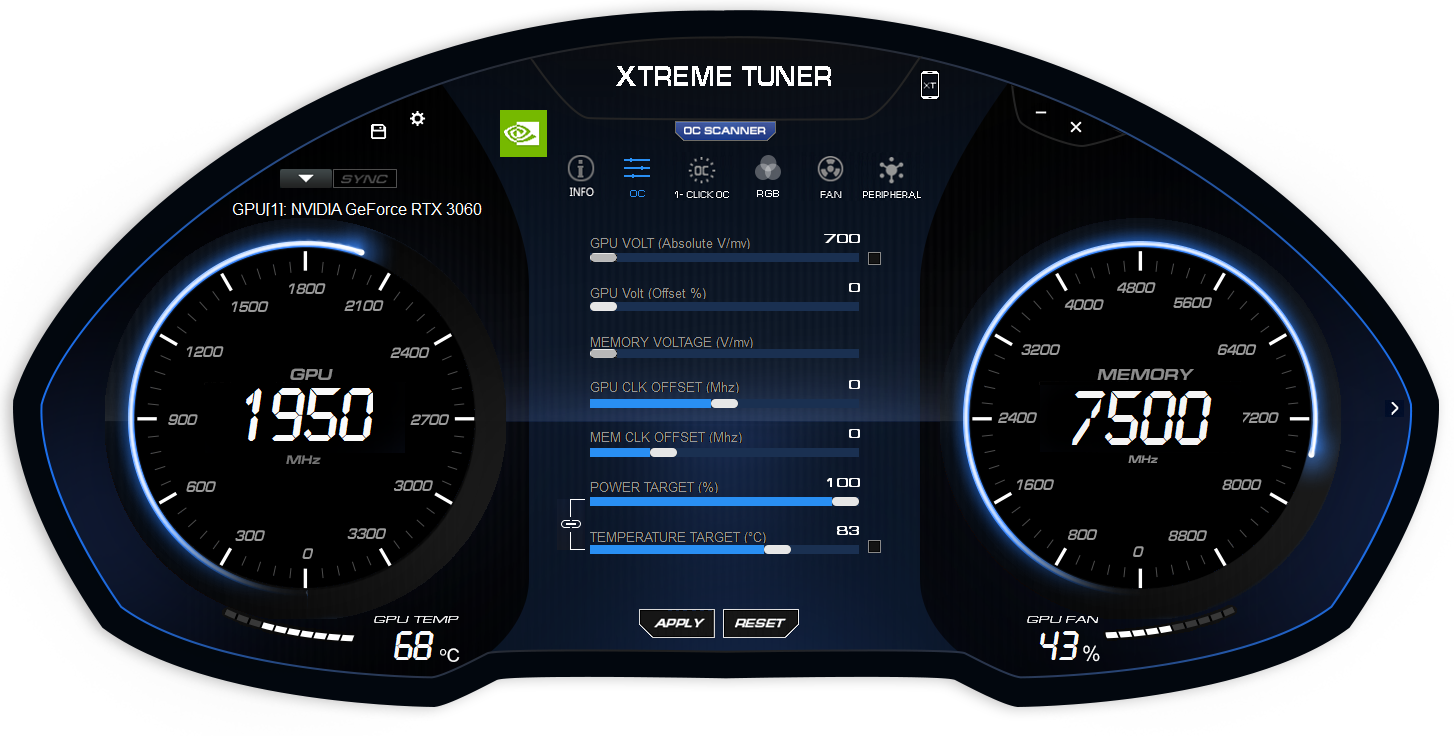
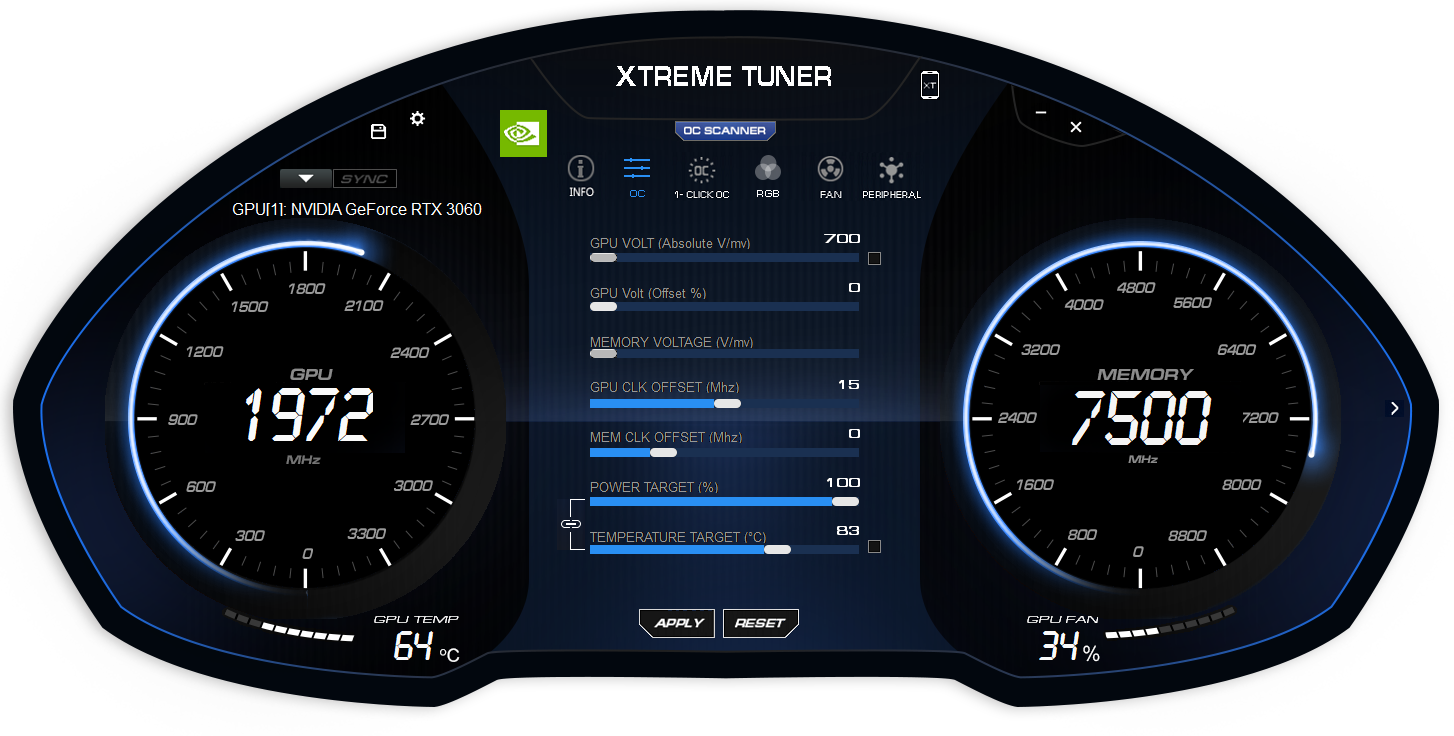
Pardon me while I rant for a moment, but I really despise having to install extra software just to access an advertised feature. I also think putting "(1-Click OC)" into the product name is silly in the extreme. How much does the extra 15 MHz boost offered by the software matter? Less than one percent, which is pretty much within the margin of error for any benchmarks we might run. There's not even a boost to power targets or anything else, so there's very little reason to lock it away behind a software install. Asus and ASRock do this as well, but at least the power limits usually increase by 10%. Anyway, let's be clear: I don't like it. Just give us one defined set of clocks and let the users who care enough to tweak things do so.
In practice, Nvidia's GPUs almost always exceed the official boost clock specs while gaming, which means cooling and power limits end up playing a bigger part in determining performance than just looking at the specifications. So let's take a closer look at the Galax RTX 3060 EX.
Meet the Galax RTX 3060 EX

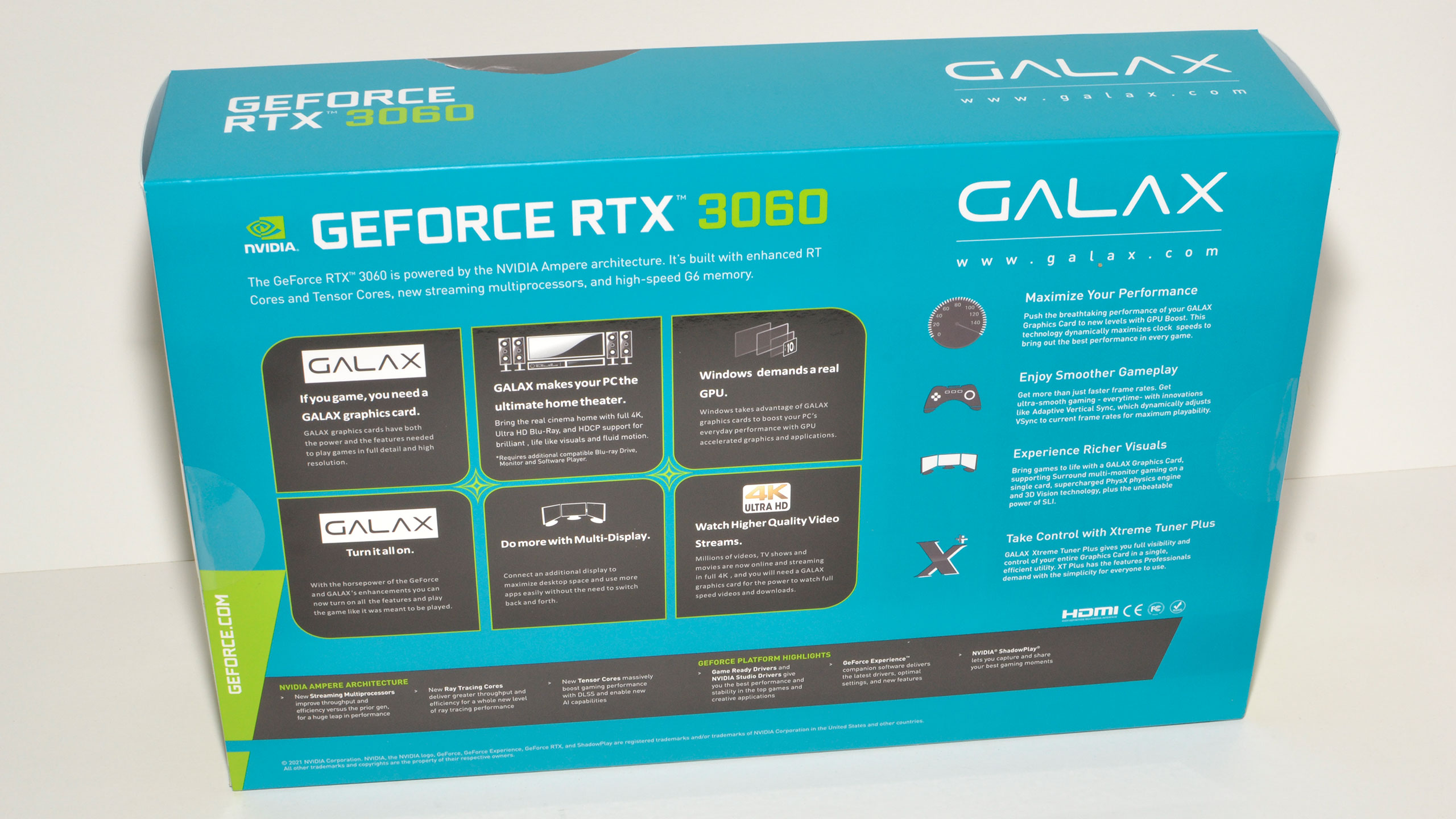
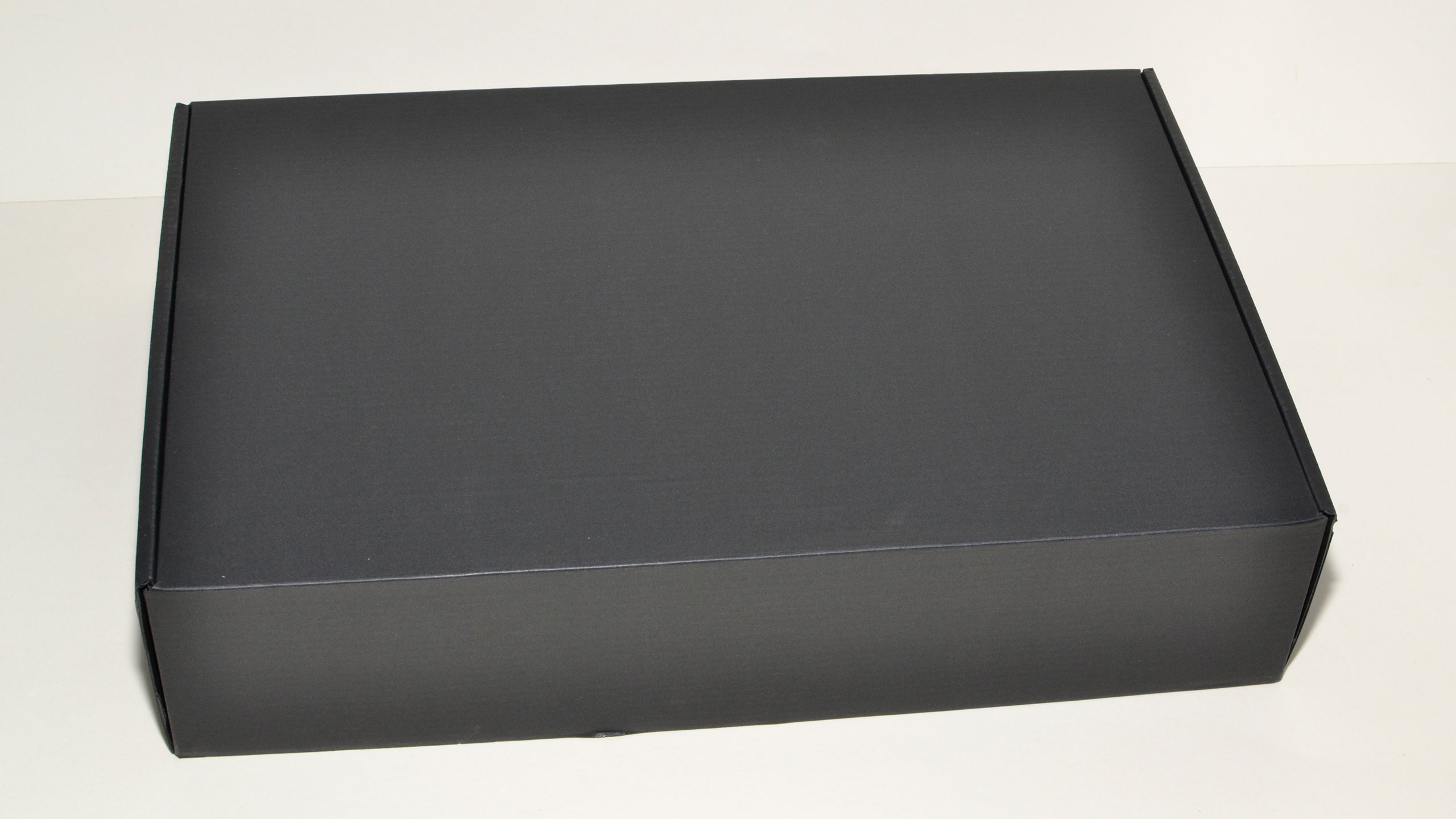
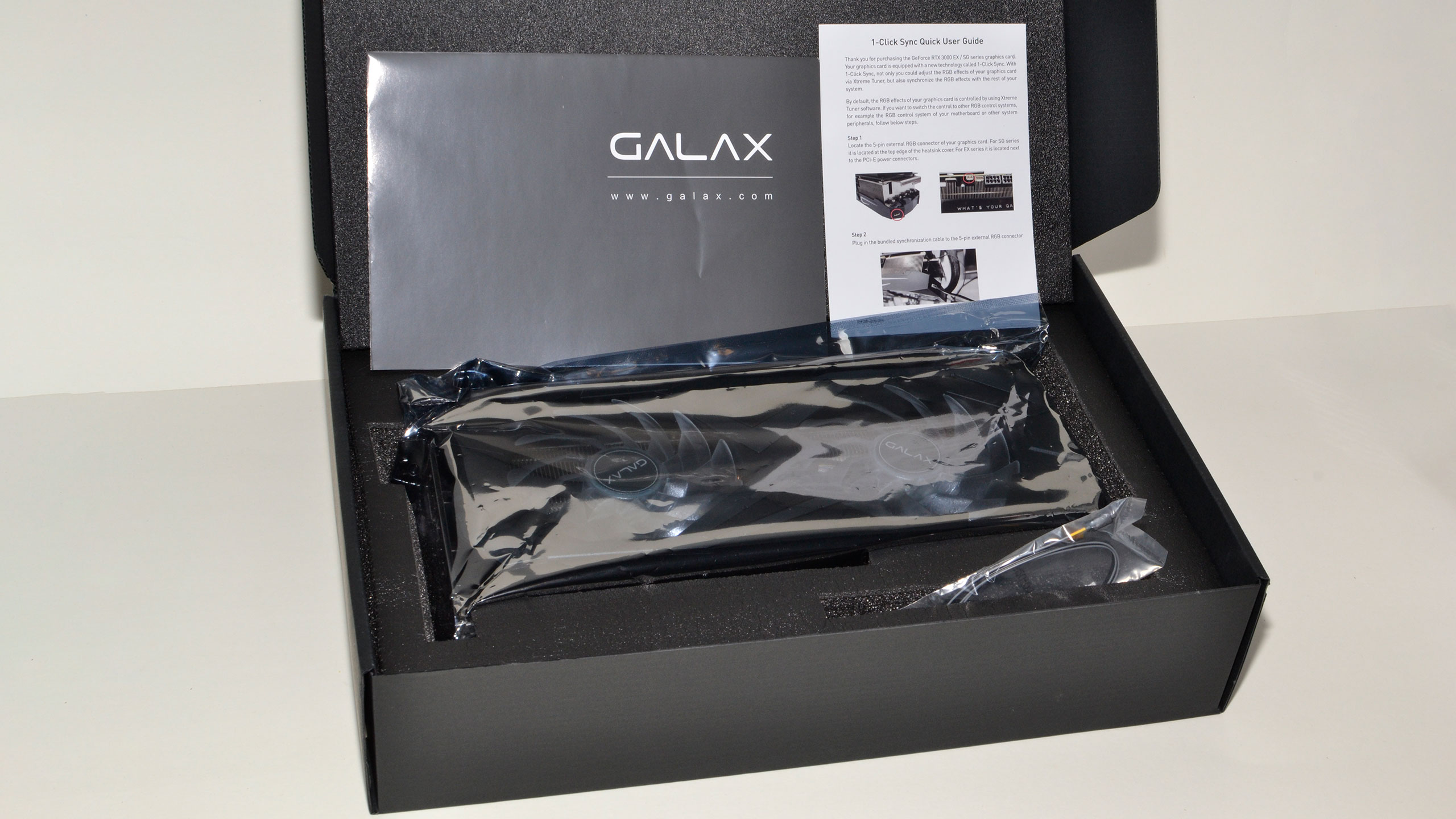


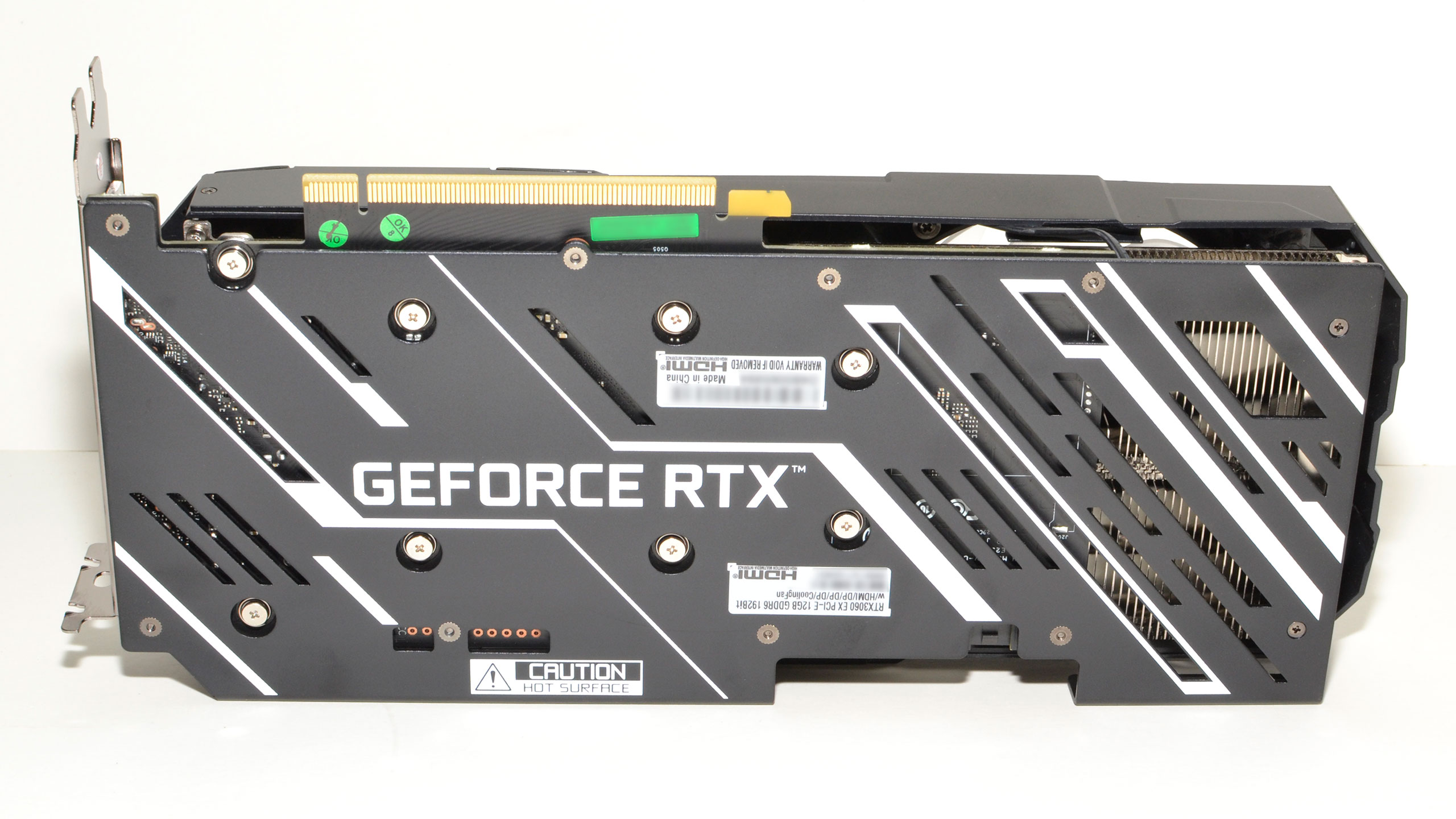
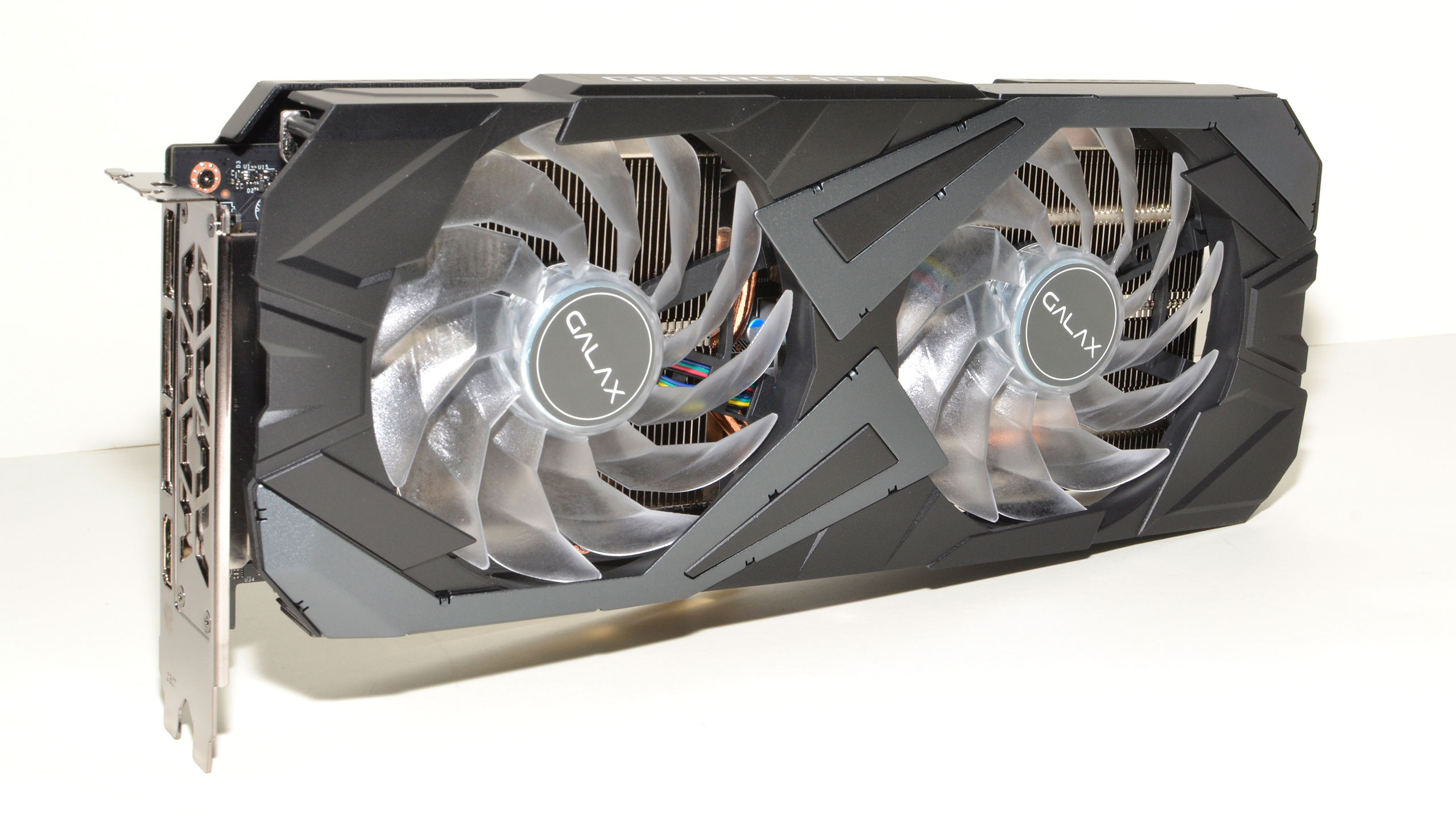
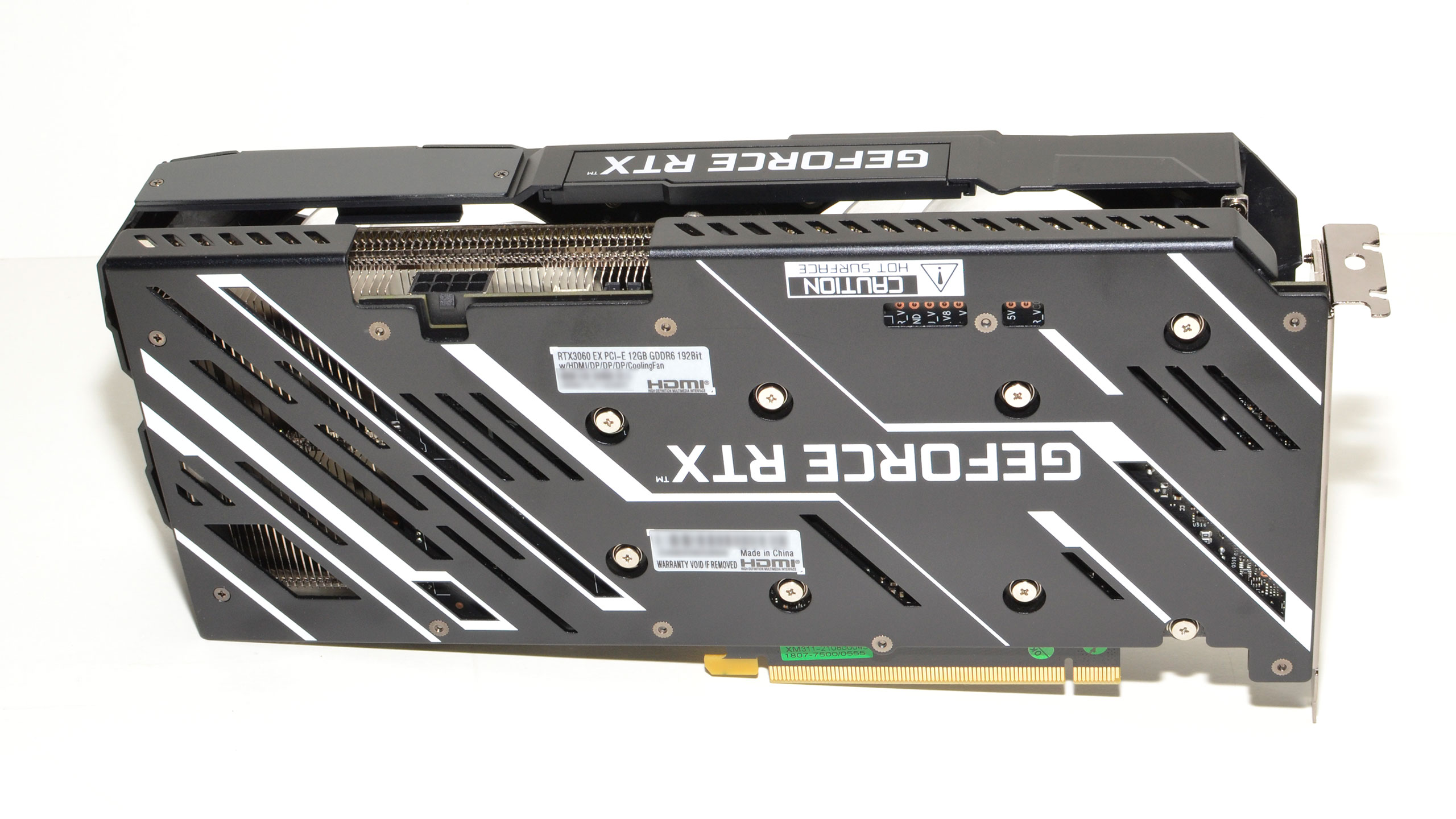
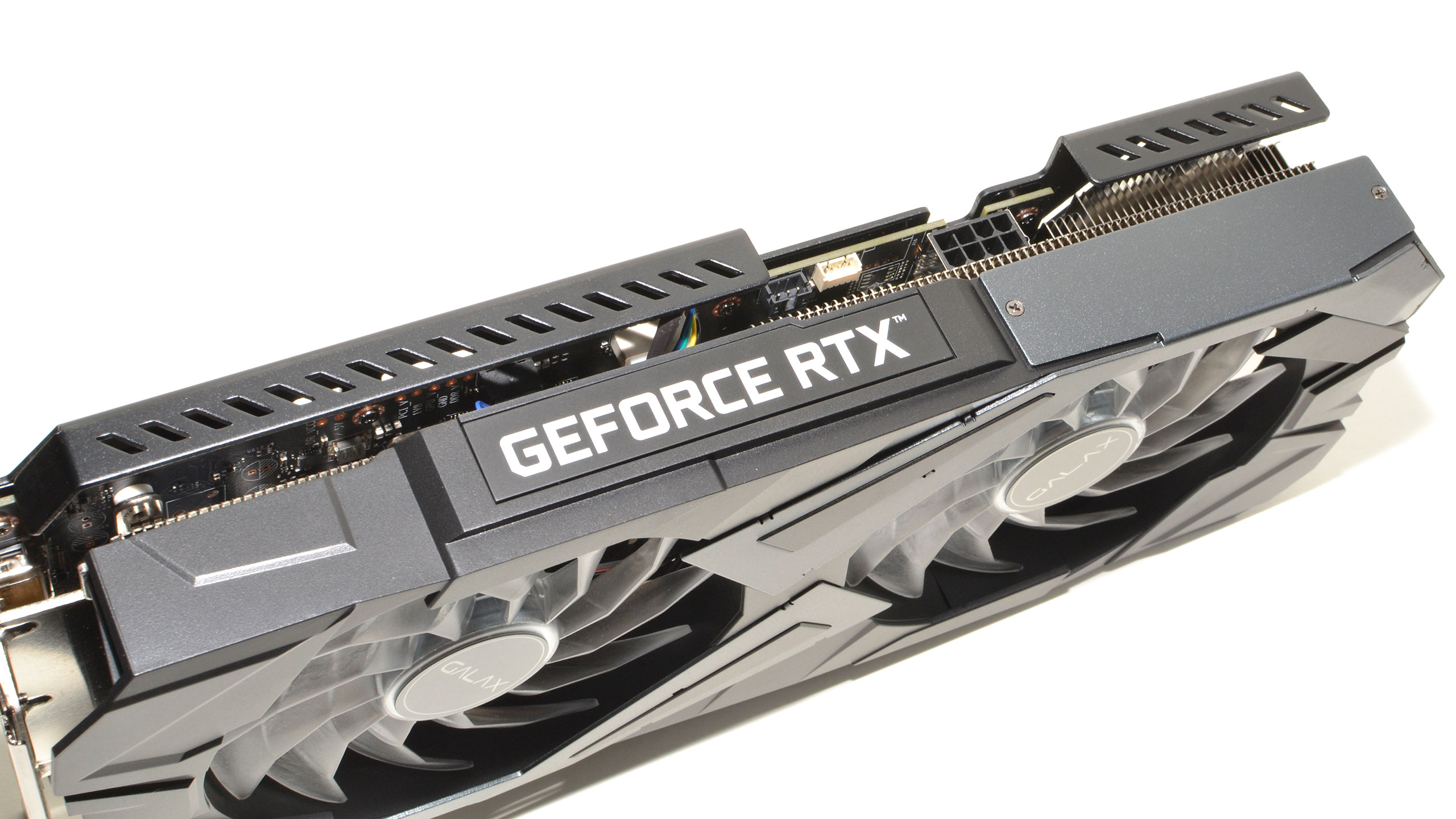
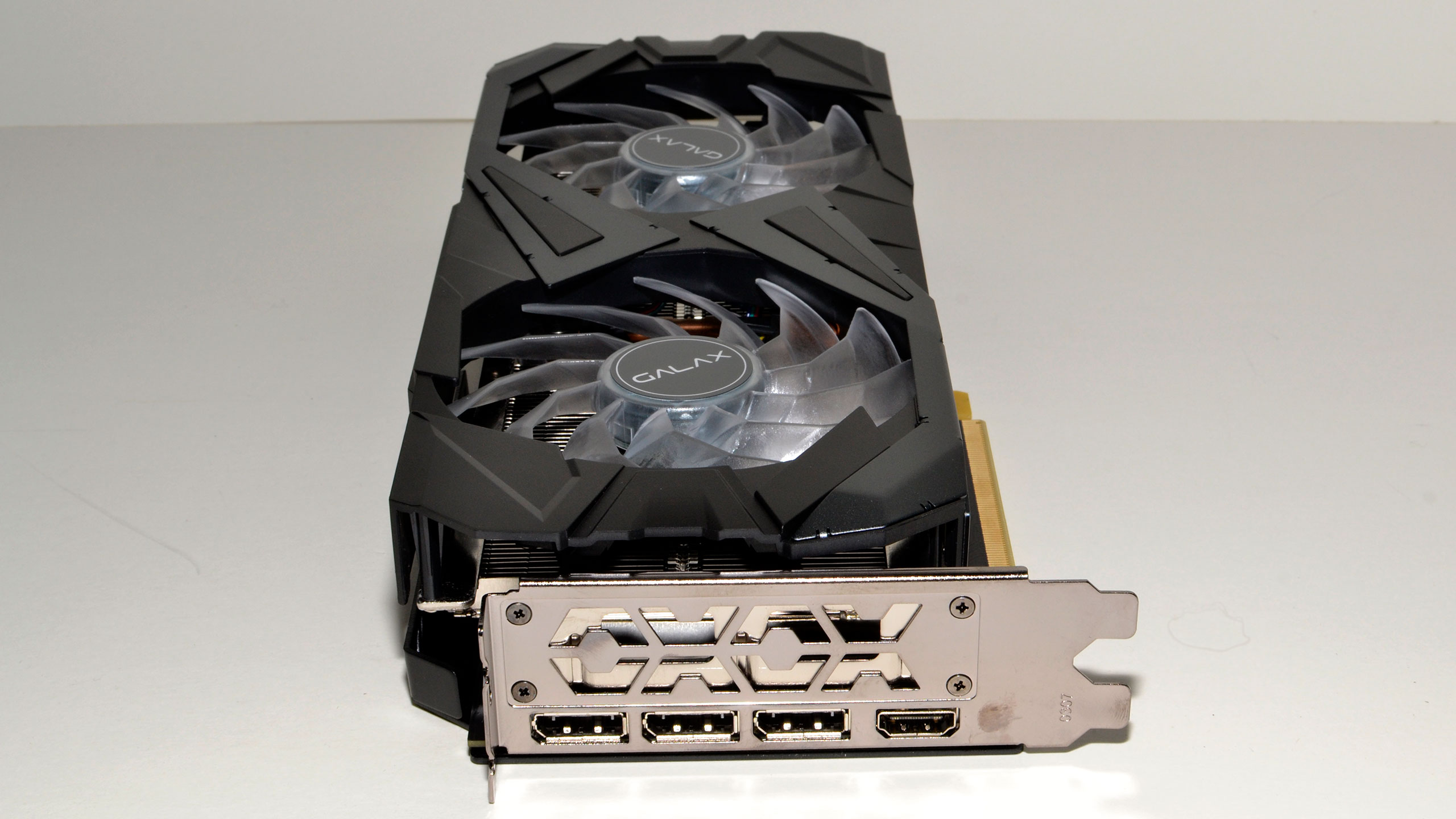
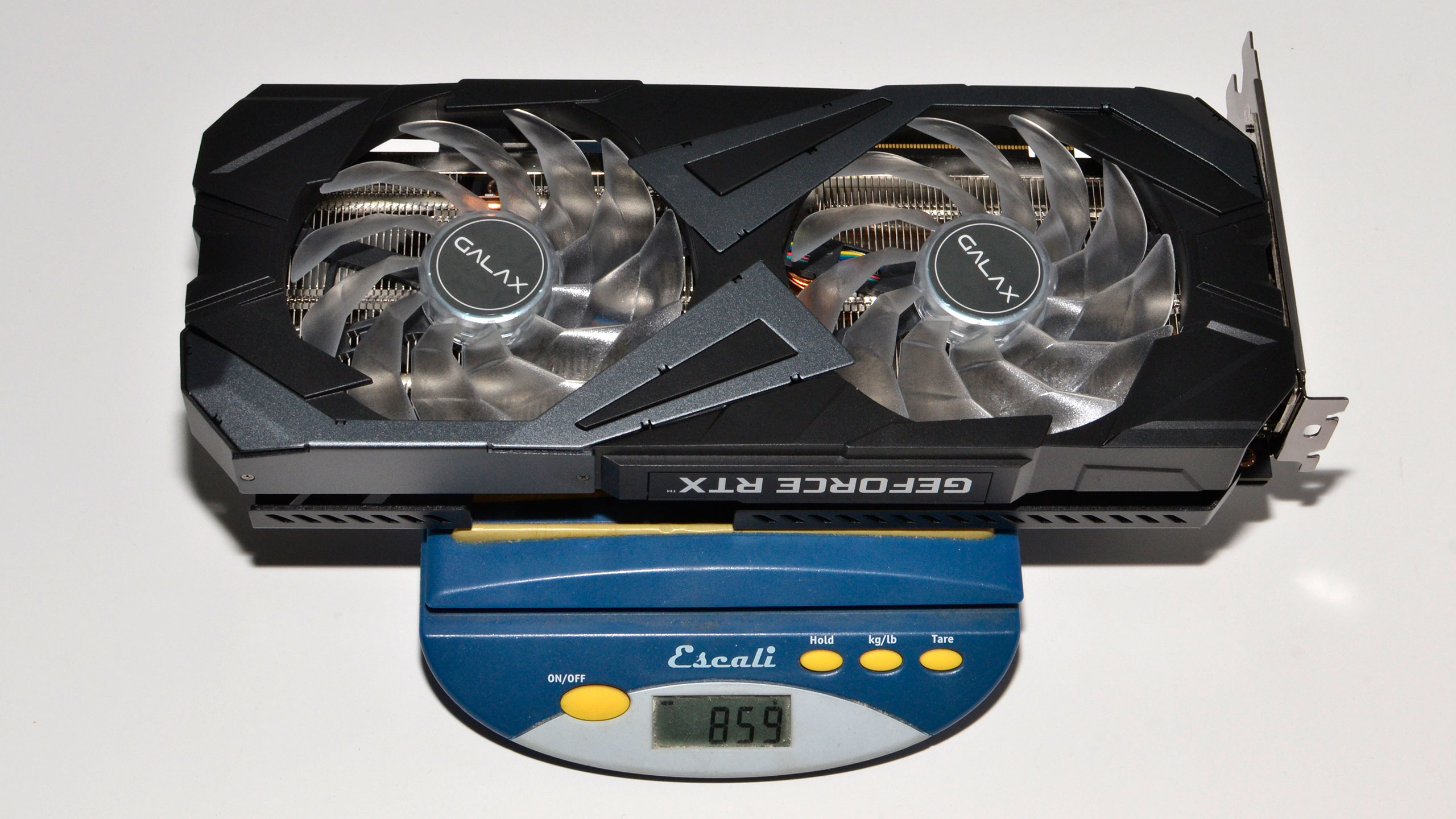
The Galax RTX 3060 EX aims for a middle ground between the larger triple-fan cards and more compact dual-fan models. It has two fans, but they're moderately large 102mm models — with customizable RGB lighting, if you like the bling. The card measures 287x127x48mm — about a 2.5-slot width — and weighs 859g. In contrast, the EVGA 3060 card has a relatively compact design that measures 202x110x38mm and weighs 653g, with two smaller 87mm fans. In the world of GPU coolers and fans, larger generally means better, and while the RTX 3060 only has a 170W TDP, well within the capabilities of either cooler, we'd expect the Galax card to be a few percent faster while running cooler and quieter.
Video ports consist of the typical three DisplayPort 1.4 and one HDMI 2.1 outputs, which we see on virtually all modern graphics cards. A few models may opt for a dual HDMI and DisplayPort configuration, and higher-end models might even go with three DP and two HDMI, but most people will be fine with the maximum four monitor outputs.
As you'd expect, the Galax card has a single 8-pin power connector, which should be more than enough for the card's needs. Near the power connector, Galax also includes RGB connections that allow you to synchronize the lighting with your motherboard and other peripherals if desired. Or if you prefer, you can install the Galax software suite to control the lighting effects.
Aesthetically, there's not much else to say. The Galax design follows well established norms, with a partially cut-out backplate that allows air to flow through the rear fan and heatsink area, and some white accents. There's also a "Caution, hot surface" warning label, though it's probably not necessary on the RTX 3060 — probably a holdover from the designs on the RTX 3070 and above. This is a relatively generic-looking card, but as the saying goes: if it ain't broke, don't fix it. As we'll see later, the cooling and design work well, and for those who just want a graphics card that gets the job done with minimal fuss, this will suffice.
Test Setup for Galax GeForce RTX 3060
We're nearing the end of 2021, and we plan on switching things up on the hardware and software side once 2022 rolls in. For now, our test hardware remains the same. We're running Windows 10 (21H1, build 19043.1237), with an MSI Z390 Ace motherboard that has resizable BAR support enabled. Our test platform doesn't support PCIe Gen4, which is one of the changes we'll be making next year, but in previous testing that we've conducted the relatively old Core i9-9900K and DDR4-3600 memory continue to do just fine.
We're sticking with the same 13 games we've been using since the RTX 3080 launch, all with DXR (DirectX Raytracing) disabled. While our GPU launch reviews also look at ray tracing and even DLSS performance, for our third-party partner card reviews we trim things down a bit. The gaming test suite consists of a mix of genres and includes both AMD and Nvidia promoted games, which should mostly keep things equal.
If you do have any specific requests for tests that we've omitted, please let us know in the comments.
MORE: Best Graphics Cards
Get Tom's Hardware's best news and in-depth reviews, straight to your inbox.
MORE: GPU Benchmarks and Hierarchy
MORE: All Graphics Content

Jarred Walton is a senior editor at Tom's Hardware focusing on everything GPU. He has been working as a tech journalist since 2004, writing for AnandTech, Maximum PC, and PC Gamer. From the first S3 Virge '3D decelerators' to today's GPUs, Jarred keeps up with all the latest graphics trends and is the one to ask about game performance.
-
tacgnol06 3 generations and 4 years later this barely matches the used GTX 1070ti I bought at a bargain from an Etherium seller after that crashed, plus I couldn't buy it even if I really wanted RTX support that badly. Kinda depressing.Reply
Card still works btw and powers my Valve Index setup, don't believe everything you read about used crypto cards being unusable for gaming.